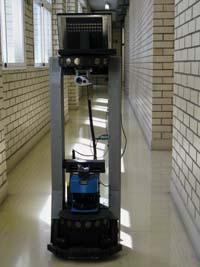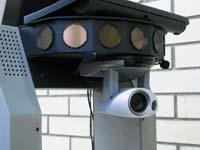Robot Tartalo, jamba
2008/06/01 Ochoa de Eribe Agirre, Alaitz - Elhuyar Zientziaren Komunikazioa Iturria: Elhuyar aldizkaria

With these sensors, and with the computer that is the brain of the robot, Tartalo would only have to move from one side to the other safely, that is, a basic English navigation called wandering. However, this team of researchers from the Department of Computer Science and Artificial Intelligence wants the robot to be able to attend a specific ordered point.
Guiding inside the buildings
The best-known machines that will drive us from a specific point to a destination are GPS navigation systems. However, they do not work within buildings and it would not be practical to create a database that collects the blueprints of all buildings in the world. Therefore, the team of Basilio Sierra is based on biomimetic systems for the development of Tartalo. That is, the robot does the same thing that people and animals would guide in a new place: explore the place and take reference points. But in order for a machine to do what living beings do with their intuition, computer scientists must insert a series of data and calculation programs.
The buildings are semi-structured environments, in all of them you can find common areas and Tartalo has taught you to know four of them: room, corridor, hall or entrance and crosses. Thus, if we took the robot to our house, it would first perform a process of self-location, giving a weight lap to learn the location of these spaces. With this process, the machine would form a kind of topological map, and we should only show the name of each of the places it learned. To do this, UPV researchers are designing human-robot interaction systems. For example, a voice recognition system and a touch interface are being adapted for the robot to understand the commands.
Single eye, sharp vision

The most important thing they have shown Tartalo is to identify the doors. In fact, to reach most of the indicated places, the robot must access through a door. Therefore, it has the camera located at the same height as the door knob, which will help you identify the door. At this time the system is programmed to search and pass through doors when circulating through a corridor. If the door is closed, as arms have not yet been installed, the door is hit by the 'legs', with two or three collisions.
The team of researchers of the UPV-EHU aims to develop the navigation system of the robot, and to achieve this it is essential to detect the doors. From there, Tartalo will have to learn to distinguish many other things, such as faces, voices or anything you are asked to bring. But each of these actions involves the development of a specific program, which is currently outside the research line of the Group of Robotics and Autonomous Systems. However, this robot will gradually incorporate the capabilities developed by other research groups.


Gai honi buruzko eduki gehiago
Elhuyarrek garatutako teknologia





